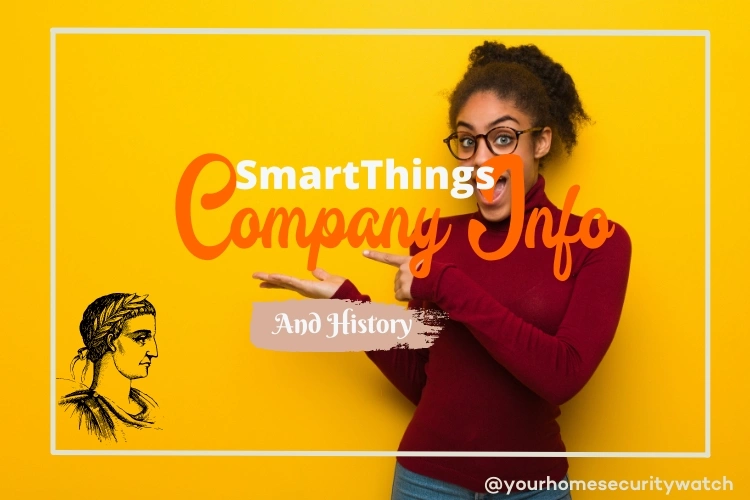SmartThings Company Info And History
by Robert Fox
In the grand scheme, SmartThings hasn't been around long, but in the short time that it has, it has blazed trails and made a name for itself in the tech world and, more specifically, in the world of smart home automation.
Contents
SmartThings operates on an open platform to be used with smart homes, and they are famous for their own hub (aka home controller or gateway), which is compatible with a growing number of smart home devices, as well as a cloud platform, and several apps.

How SmartThings Came About
The birth of SmartThings was actually as the result of a particular misfortune of Alex Hawkinson (current CEO), who experienced extensive damage to his home after some frozen pipes burst during the winter time in 2011. The damages added up to a depressing $80 000.
This caused Alex to think about how this problem could have been prevented, and his answer was to create a technology solution which would have allowed him to know about the problem in time to prevent the catastrophe. It was at this point that Alex and the other co-founders of SmartThings set about making their first working prototype.
What Does SmartThings Offer Today?
The main products offered by SmartThings include their app, their hub, and a variety of sensors. This is the heart of the SmartThings business, but it is not limited to these things. The line of SmartThings products also includes:
- Motion sensors
- Presence sensors
- Moisture sensors
- Locks
- Electrical outlets
- Garage door openers
- Speakers
- Thermostats
SmartThings starter bundles can have a number of different combinations of things therein, with the basic being the one we mentioned with the app, the hub, and a few motion sensors. From there, you can expand to as many devices as you like. Another bundle comes even more devices, such as a moisture sensor, smart outlet, multi-sensors, and more.
[amazon tag="yourhomesec-20" type="button2" value="https://www.amazon.com/s?k=Samsung+SmartThings" text="Click for Price"]
So what does the SmartThings app do? It allows users to have complete control over their home environment using smart devices, and also customize those devices completely to fit their specific needs. While the hub is integral to this set-up, the way you interact with the hub is through the app, and SmartThings have gone to great lengths to make their app user friendly. From your smart phone, tablet, or PC, you can connect to configure all of your devices.
The hub itself uses such protocols as ZigBee, Z-Wave, IP access, and connects to a home's internet router. The hub is the link between all of your devices and the SmartThings app.
SmartThings History And Evolution
Alex Hawkinson went on to found SmartThings with a group of other tech-minded individuals in 2012, and raised the money to launch the company as many tech startups do these days - on Kickstarter. The fledgling company out of Palo Alto, CA was able to raise a formidable amount ($1.2 million), and from there, things began to get bigger and better.
Here is a picture of the first generation SmartThings Hub.
Before the year was out, SmartThings had won the Spark of Genius at the Dublin Web Summit and also received €100,000. From there, they then won an additional $3 million to put towards their product in December during a seed funding round.
In short order, the middle of 2013 saw SmartThings begin selling products commercially via their own website, and then soon after on Amazon.
SmartThings App Updates
In terms of app user friendliness, SmartThings know what's up. In 2013, when things were just beginning for them, they made sure to update their app to be iOS friendly and super user friendly, which was smart move on their part.
This update included a beautifully designed user interface where things are labelled quite logically as "doors and locks", "lights and switches", and so forth. The update also incorporated "rule-building", which meant users could customize their SmartThings home automation devices as they pleased. There was a major buzz about this at the time, and their sales jumped up quickly after the update was rolled out.
Hub Expansion & More Devices
Less than a year later, in 2014, SmartThings updated their mobile app once again. This update allowed for a wider range of user actions as well as alerts, and an even simpler design. Also, it was easier to add more devices to the app, and control them with the hub. By this time, the number of devices that could be managed by the SmartThings hub reached in excess of 100.
Standardization For Developers On The Open Platform
Although the platform was designed to be open, to make things easier for developers and manufacturers to add devices that would be compatible with the SmartThings hub, SmartThings added an easy-to-follow process that made it easier for them to create devices and apps for SmartThings. This included the addition of a certificate program, an approval process with formalized submissions.
Here is an informative video which talks about the development of the SmartThings platform.
Overall, the development of their resulted in better communication and a higher quality standard for SmartThings and its developers, resulting in better device integration overall. This resulted in more options for the consumer, with more high quality products with easier installation and usage.
Live Smart Home Demos
To show off their new system, SmartThings rented a home in Las Vegas in January of 2014, where people could visit their rented home and see SmartThings in action. This home was meant to demonstrate the technology, and wowed customers with a demo that involved one device called the Jawbone UP24 going through a morning wake up routine. This included turning on lights, brewing coffee, and turning on the news. Other companies who were featured included Belkin WeMo, Sonos, and Philips Hue.
It was mid-2014 when SmartThings saw its partnership with Canadian and American energy provider Direct Energy, which meant that more homes would be able to use SmartThings products. Energy management is one of the prime directives of SmartThings, along with home security and home automation. The collaboration between these two companies saw the development of a plan offered to consumers which included SmartThings starter pack including both a hub and sensors, as well as an economical fixed-term energy plan.
Samsung Acquisition of SmartThings
2014 was definitely a big year for SmartThings, and saw its acquisition by Samsung for $200 million. On on hand, this move made it possible for Samsung to move more towards the home automation space, while SmartThings benefited by having the ability to operate autonomously within the Samsung merger.
In 2015, Samsung Smartthings Hub arrived back and better than ever. The SmartThings team had not been idle, and their new lineup included a new app experience and new products. Video streaming was the key feature of this release, with longer battery backup, and product performance was improved upon. Sensors shrank and became smaller and sleeker, as well as more modern. The SmartThings app, good as it already was, had been upgraded for a more intuitive experience.
Its 2016, and SmartThings continues to innovate and expand. Visit their website here: http://www.smartthings.com
More from my site
 |
 |
 |
 |

About Robert Fox
Rob Fox is a former hydro worker who used to teach self defence in Miami for 10 years. He's currently enjoying his retirement, playing cribbage and golf with his buddies, locksmithing and home security in his spare time. Rob is an avid reader, and has even written a few books on the subject of self defence.
Thoughts on "SmartThings Company Info And History"
 |
 |
 |
 |
You can Get FREE Gifts. Furthermore, Free Items here. Disable Ad Blocker to receive them all.
Once done, hit anything below
 |
 |
 |
 |